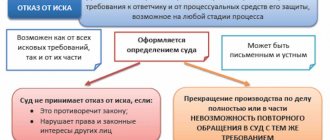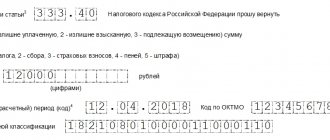Grounds for refusal to accept a claim
- Incorrectly defined jurisdiction. The application of this basis is associated with the delimitation of competence between the Constitutional Court of the Russian Federation, courts of general jurisdiction, administrative and arbitration courts. For example, a civil court will not consider a claim that should be considered by an arbitration court. In this case, the applicant must correctly determine the jurisdiction and jurisdiction and prepare a new statement of claim.
- The presence of a court decision that has entered into force on an identical claim. In this case, an identical claim should be understood as a statement of claim in which the parties to the case, requirements and grounds for filing coincide.
- Lack of rights of the person who filed the claim in court. Due to the lack of a power of attorney to represent interests in court; in cases where circumstances that are not related to the rights and interests of the applicant are disputed, except for cases where the current legislation of the Russian Federation clearly establishes the circle of persons who have the right to go to court to protect the rights and legitimate interests of other persons, namely: the prosecutor in the case when a citizen, due to his health, age, or incapacity, cannot go to court to protect his violated rights and legitimate interests; guardianship and trusteeship authority of a municipality in cases where it is necessary to protect the rights and legitimate interests of children left without parental care or other legal representatives; authorized executive body for control in the field of consumer rights protection.
- Availability of a decision to terminate proceedings in a civil case on the basis of the applicant’s refusal of the claim or a settlement agreement;
- Availability of an arbitration court decision on an identical case.
If a claim is refused, the judge, within five calendar days, issues a ruling indicating the reason for such a decision. This document is delivered to the applicant in person or sent by mail along with the statement of claim filed with the court.
This is important to know: How to restore a child’s birth certificate: how to obtain and the amount of state duty
Having received a reasoned refusal to accept the application, the plaintiff can appeal it within ten days by filing a private complaint with the appellate authority.
USEFUL: watch the video with the basic rules about filing a claim in order to win it in the future, write your question in the comments of the video
What is a private complaint against a court ruling?
Issues that arise during the consideration of the case are resolved by the court by issuing a ruling. For example, a determination on the appointment of a forensic examination. Or about postponing the case. However, some definitions may lead to unfavorable consequences for the participant in the case. For example, the court will make a ruling to terminate the proceedings, but the plaintiff does not agree and considers it necessary to resolve the issue on the merits. After all, he will no longer be able to appeal to this defendant with such a claim. Or the court issues a ruling to impose a judicial fine. And the one to whom it was applied does not agree that there are grounds for this.
Not all rulings of the court of first instance can be appealed. But only those that are directly indicated by the Civil Procedure Code. And those that make it impossible to consider the case on its merits. As a rule, the definition itself contains an indication of the possibility of appealing it by filing a private complaint.
A private complaint can be filed within 15 days from the date of the court ruling. If a complaint against a ruling is filed separately from an appeal against a court decision, then it is called private.
| It is important! |
| A private complaint is a complaint against a court ruling, which is filed separately from an appeal. |
Private complaints are filed through the court, which considers the case on its merits as the first instance. If the applicant misses the deadline, it can be reinstated. To do this, a corresponding petition must be drawn up. Moreover, a private complaint should only be filed simultaneously with such a petition.
| Note! |
| Application for restoration of the deadline for filing a private complaint |
A private appeal against a ruling by a magistrate is considered by the district court. For the determination of the district court - the regional (city, regional, republican) court.
| Note! |
| Private complaint against the ruling of the magistrate |
Cases of returning a statement of claim
In addition to refusing to accept the statement of claim, the court may issue a reasoned ruling to return the filed claim if:
- The procedure for pre-trial settlement was violated. When faced with a violation of the law by officials, in some cases the law obliges a citizen to send a complaint or claim to the violator to protect and restore his rights and legitimate interests as soon as possible. If the claim is successful, the parties to the dispute draw up a corresponding agreement in writing, which, if necessary, can be certified by a notary.
- The claim is brought by an incompetent person, that is, a person who, due to not reaching the age of majority or due to a mental disorder, is not able to exercise his civil rights and obligations in the absence of guardians or trustees;
- Jurisdiction is not respected;
- The application is not signed by the applicant or signed by a person who does not have these powers due to the lack of a power of attorney to represent the applicant’s interests in court;
- The presence in the proceedings of the plaintiff’s application for the return of the claim, which the citizen can submit to the court before the court makes a ruling on accepting the submitted application for proceedings;
- There is an identical case in court proceedings.
The decision on return is made by the judge within five calendar days, after which it is sent to the applicant (plaintiff).
State duty
Applicants are accustomed to the fact that if they need to file a claim in court, this is certainly accompanied by a requirement to pay a state fee in a fixed amount or in an amount calculated on the basis of the price of the claim. The amount of state duties paid and the rules for their calculation are contained in the Tax Code.
The Tax Code does not contain any mention of the need to pay a state fee when filing a private complaint against the refusal to accept a statement of claim. These rules apply throughout the country, regardless of where the complaint is filed.
Thus, in the process of filing a private complaint, no state fee is paid.
What to do when returning a claim?
The return of the statement of claim to the plaintiff means the court’s refusal to initiate a civil case. Unlike the court’s refusal to accept an application, the return of a claim does not deprive the citizen of the right to re-apply to the court with the same claim.
Expert opinion
Pankov Roman
If the court returns the statement of claim, then you, as the applicant, need to restore the validity of the document. There are two ways to restore the action:
This is important to know: An example of an application for the collection of alimony and division of property
- by making amendments to the returned application;
- by appealing a court decision in a case where, in the plaintiff’s opinion, the reasons for the return are not objective.
Where to send a complaint
Like other forms of complaints related to disagreement with the actions of the judicial authority, a private complaint is transferred to a higher authority. For example, if a claim was initially filed in a city court, then it is redirected to the district court, etc.
The following may act as a higher authority:
- Appeal structure in case of refusal to accept an application by the court of first instance.
- Cassation structure - if the refusal came from the appeal.
In this case, the applicant himself submits the complaint to the original judicial authority, and the latter itself forwards it to a higher authority.
Help from a lawyer in filing a claim in Yekaterinburg
As practice shows, very often the court returns statements of claim due to production errors made by the applicant when preparing the document.
For greater confidence in a positive outcome of the case, we recommend that you contact professionals in your field. Our lawyer will help you draw up a complaint against the ruling in accordance with all the rules and will provide effective assistance in its satisfaction by a higher court, as well as clarify the claims, if necessary, correct the statement of claim so that the court accepts it for proceedings and protects your rights and legitimate interests.
Deadlines for filing objections
Since objections are classified by law as optional procedural documents, which may or may not exist, there are no deadlines for their filing. This means that filing objections must be within what is called a “reasonable time frame.”
“Reasonableness” means the timely introduction of objections so that they are sent to the appellate authority together with a private complaint or separately, but always some time before the day of the appeal hearing.
Causes
The reasons why the court returned the statement of claim may be the following:
- The plaintiff did not take care to comply with the procedure for pre-trial resolution of the conflict (this procedure is established by the Federal Law for the designated category of disputes, and is also provided for by agreement of the parties) or did not provide documents that serve as evidence that the plaintiff followed the procedure for resolving the dispute before trial;
- This court does not deal with such cases;
- The claim was filed by a citizen who is incapacitated;
- The claim was not signed or was signed and filed by a citizen who does not have the authority to sign and go to court;
- The same case is already being considered by this or another court;
- Before the claim was accepted for proceedings, the court received an application for the return of the statement of claim.
These reasons for returning an application are regulated in Art. 135 Code of Civil Procedure of the Russian Federation.It is also worth noting that the claim may be returned in the following case. The judge decided to temporarily leave the lawsuit pending until the plaintiff resolves certain issues.
However, the plaintiff did not comply with the judge’s conditions within the specified time frame. This situation is regulated in Part 2, Article 136 of the Civil Procedure Code of the Russian Federation.
The state fee can be returned if three years have not passed since the previous decision was made and if an old receipt for payment of the state fee is attached to the second statement of claim.
Court for dummies. "return of claim by determination"
Among the court's tricks is the so-called “return of the claim by determination.”
It would seem – what’s so bad about returning a claim?
Well, let’s say, a citizen filed a lawsuit in defense of someone else who did not ask him to file a lawsuit, or did not indicate how his rights were violated, or filed another lawsuit that had already been considered once.
“Civil Procedure Code Article 135. Return of the statement of claim
2. On the return of the statement of claim, the judge issues a reasoned ruling, in which he indicates which court the applicant should apply to if the case is not within the jurisdiction of this court, or how to eliminate the circumstances that impede the initiation of the case. The court ruling must be issued within five days from the date of receipt of the application by the court and delivered or sent to the applicant along with the application and all documents attached to it.
3. The return of the statement of claim does not prevent the plaintiff from filing a lawsuit again with the same defendant, on the same subject and on the same grounds, if the plaintiff eliminates the violation. A private complaint may be filed against the judge’s decision to return the application.”
Did you notice anything? It would seem that there are no catches... However.
“The plaintiff did not specifically indicate which specific rights were violated. The lawsuit was left pending until March 10. In case of failure to comply with the court’s requirements, the claim will be returned to the applicant.”
And what should I indicate here? What was all the talk about? Which claim did it relate to?
But that's not the point.
And the fact is that the ruling dated April 15th is sent to you by the court on March 4th, it arrives at your post office on March 9th, on the 10th they put a notice in your mailbox, which you take out on the 11th, to the post office, respectively, earlier You can’t come on the 12th, and so, the procedural deadline has been missed.
For those filing a claim for the first time, this may be an obstacle, but not for us, who immediately write a blank with “I ask and send this blank immediately, a reasoned appeal within 15 days after receiving the determination.
But the judge is much more cunning than we imagine.
On March 16, you receive another ruling from the court, dated March 11: “The claim has been returned because the court’s demands have not been fulfilled” (What demands, what claim - about this too, of course, not a word.)
This definition comes in one piece of paper.
Your claim is not in the letter, what was discussed there, you do not submit (especially if several claims are filed at once) for appeal (and an appeal against the return of the claim requires the filed claim as an attachment) You are not able to attach it, nor your paid state duty .
While you are demanding clarification, your claim (which sometimes you receive, and sometimes not), your state duty, the procedural period again passes.
“The claim was returned by DETERMINATION. The determination, according to the notification of delivery, was received by you on March 16. References to the fact that there was no claim in the letter are untenable, since according to the current legislation, the determination to return the claim is subject to appeal within 15 days. There are no grounds for reinstating the procedural deadline (serious illness, infirm condition). Refuse."
Content and structure of the complaint
The complaint does not have an approved form and is drawn up in a free format. But it is necessary to specify in it the entire range of information necessary for the court, which is prescribed in the Code of Civil Procedure.
In a complaint against a court ruling to return a statement of claim, the following information must be included:
- The name of the court to which the document is submitted.
- Full names of the parties : plaintiff, defendant.
- The applicant's residential address and place of registration.
- Applicant's contact details.
- Details of the statement of claim that was filed in the original instance.
- Information about the court ruling on the return of the statement of claim.
- Incorrect or unlawful actions of the court , which led to the need to file a complaint.
- Confirmation of the legality of the claims made with reference to the legislation.
- The applicant's specific demands : to cancel the court's ruling to return the statement of claim.
- Complaint date.
- Applicant's signature with transcript.
The complaint should be prepared in two copies. When submitting it to the court, you must receive one copy with a mark of its acceptance indicating the date of receipt. This will allow, if necessary, to counteract the delay of the trial.
If the document is sent by mail, the applicant must ensure the safety of the contents and the receipt for payment of postal services.
Content
The statement with which the plaintiff subsequently applies to higher authorities must include the following components:
- Full name of the judicial authority to which the complaint is being filed;
- Address of the judicial authority;
- Through which judicial authority is the application submitted?
- Full name, address, telephone number of the plaintiff;
- Full name, address and telephone number of the defendant;
- Full name, telephone number and address of the third party;
- Reasons for returning the claim;
- Reasons for the plaintiff’s disagreement with the return of the application;
- Circumstances proving that the return of the application was not carried out on the basis of the law;
- Plaintiff's request;
- Applications - list of documents provided. For example: a photocopy of a private complaint, a returned claim with attachments, a photocopy of the returned claim and others;
- Date of;
- Signature.
Below you will find a sample of a private complaint, which clearly shows how a complaint against a ruling to return a statement of claim is drawn up and filled out.
Consequences of returning an appeal
If a citizen refuses to appeal the claim, the prosecution or defense is deprived of the opportunity to re-apply and appeal the decision in the courts of first instance in this case.
Moreover, the restriction applies even in cases where the period for appeal has not expired. Therefore, before submitting an application, it is important to objectively evaluate your own decision. In the future, the document will be reviewed by the court without fail.
For civil, administrative or criminal cases where the appeal is filed by several participants, the return of one person does not affect further legal proceedings. An appeal will also be heard against the remaining parties.
How to write a waiver of appeal
To ensure that the court does not refuse the applicant to stop a civil, arbitration or criminal case based on a previously filed petition to correct or cancel a decision, it is important to comply with the basic requirements for completing the application.
The document should include five blocks:
- Header – located in the upper right corner. Alternately, the name of the authority, full name, residential address and contact number of the applicant are indicated on a new line.
- The main part is in the center of the paper sheet. Initially, the phrase “Application for refusal of the appeal” is written. The new paragraph lists the details and key conditions of the act under which the applicant intends to withdraw the complaint.
- Regulatory justification is in the center under the main part. A link is provided to the article of the regulatory document, according to which the plaintiff or defendant has the right to withdraw from a previously filed complaint.
- Application. A list of documents attached to the application, including a copy of the appeal and an identity card.
- The final part is at the bottom of the page. The date of submission of the document, signature, surname and initials of the applicant are indicated.






